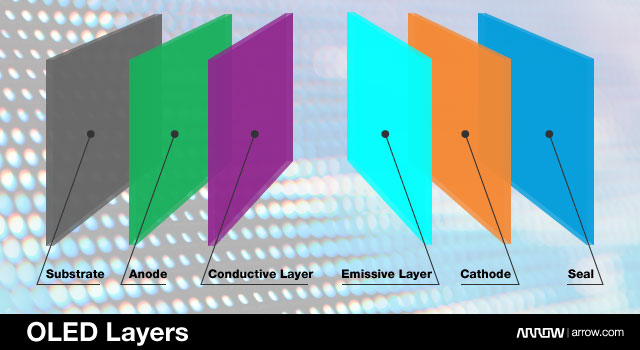Looking for the best LED display? We explain the core functionality of OLED and LED technology to help you find the right fit.
While LEDs have had decades to gain traction and design enhancements, super-thin OLEDs are still in their infancy and have only recently made way into practical consumer applications with high end electronic displays and lighting panels. We explore how both displays work and break down what makes OLEDs the next best thing to happen to display technology.
What is an LED?
A diode is a simple type of two-lead semiconductor device that acts as a one-way gate for electric current flow. An LED, or light-emitting diode, is a special type of p-n junction diode that is able to emit visible light by a phenomenon known as electroluminescence. A p-n junction diode is made up of two separate semiconductors—an n-type crystal on one side and p-type crystal on the other. The boundary between the two semiconductors is called the pn junction. When the correct voltage is applied, it causes electrons to be passed from one semiconductor layer to the other and when this happens, photons are emitted and we see light. The color of the LED depends upon the semiconductor materials and the processes used to make it.

What is an OLED?
An OLED, or organic light-emitting diode, is an advancement on the principles that make up a standard LED with a super-thin 100 to 500 nanometer thick solid-state device. (200 times thinner than a human hair!) Their basic concept and functionality is the same as an LED with regards to the p-n junction. However, rather than using semiconductor material, OLEDs have extremely thin electroluminescent organic compound layers that emit light in response to an electric current. The emissive organic semiconductor is sandwiched between two electrodes, the anode and cathode, and this layered sandwich is deposited on a substrate.
When electricity is applied, the cathode gives electrons to the organic molecules in the emissive layer, and the anode removes electrons from the conductive organic layer, creating holes. At the boundary between these emissive and conductive layers, electrons find electron holes. When the electrons fill these holes, and fall into an energy level of the atom that’s missing an electron, they give up energy in the form of a photon of light.
How Does OLED Work?
Just as with LEDs, the color of emitted light from an OLED depends on the type of organic molecule in the emissive layer. Manufacturers will place several types of organic films on the same OLED to create color displays. The light intensity depends on the electrical current applied: the greater the current, the brighter the light.
The organic layers of an OLED are made up of polymers or small molecules. The first generation used tiny organic molecules that required an expensive and labor-intensive manufacturing process. Researchers now utilize much larger polymer molecules that can be developed for lesser costs and in large sheets that are convenient for large-screen displays.
What is OLED Display?
OLED displays can be driven via passive-matrix (PMOLED) or active-matrix (AMOLED) control schemes. In a passive-matrix design, each row in the display is controlled sequentially, while active-matrix schemes use a thin-film transistor backplane to independently access and switch each pixel, enabling higher resolution and larger display sizes. Beyond PMOLED and AMOLED, there are a variety of subtypes of OLEDs such as transparent, top-emitting, white, and foldable. Each type was designed to offer benefits for specific display applications.

In general, OLED displays are known to provide brighter, crisper displays on electronic devices and use less power than conventional LEDs or liquid crystal displays (LCDs).
Advantages of OLED vs LED Displays
Currently in the consumer world, OLED displays are featured as the latest and greatest choice for big-screen TVs. LED, Super UHD, and even Quantum dot LED TVs are all fundamentally the same—just fancy LCD displays with an LED backlight. OLED televisions are actually a cut above.
LCD/LED displays use a backlight to illuminate all pixels at once and color filters to produce the color. OLED TVs illuminate each individual pixel, offering many picture quality advantages. LCDs work by selectively blocking areas of the backlight to create the images you see, while OLED pixels generate their own light. As a result, they offer a much wider viewing angle compared to LCDs, which work on the principle of blocking the backlight and actually create an inherent viewing obstacle from certain angles. In addition, they deliver deeper black levels with this ability to turn pixels off and provide a truly perfect black.
The fact that OLED displays don’t need a backlight makes them lighter, and more flexible than liquid crystal displays. This means that they consume significantly less power, which is key for enabling longer battery life in smaller portable devices such as cell phones. Because organic OLED layers are much thinner than their LED crystal counterparts, they can be multi-layered, allowing them to be brighter than LEDs. If these benefits aren’t enough, OLEDs typically offer a wider temperature range and faster response time, making them ideal for industrial use.
OLED vs LED – Which is Better?
Just as LED lighting and display technology has improved drastically over the past 10 years, we can anticipate a similar trend with OLEDs, including improved form factor, product integration and application, color quality, and cost. But even in their infancy, it’s clear that applications harnessing the advantages of OLED displays shine brighter than the competition.


